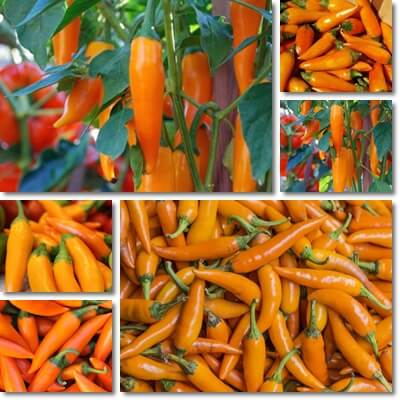The Bulgarian carrot pepper is an heirloom chili pepper variety of a bright orange color. Bulgarian carrot peppers have a fruity flavor and a mild to strong hot finish. With a medium heat score on Scoville scale, the Bulgarian carrot pepper is a significant source of pungent capsaicin with scientifically proven anticancer properties and analgesic benefits.
The variety is also high in pro-vitamin A antioxidants such as beta-carotene, known to advance eye health, and vitamin C with anti-inflammatory benefits and benefits for the immune system.
What is a Bulgarian carrot pepper?
The Bulgarian carrot pepper is a bright orange-colored chili pepper belonging to the Capsicum annuum species. The variety is also called the Bulgarian carrot chili or chile pepper, the Shipka pepper (alternative spelling: shifka), or simply the Bulgarian carrot. As its name clearly indicates, it is native to Bulgaria and a recognized heirloom variety of pepper with a long tradition of cultivation in its country of origin and likely other Balkan countries. Botanically speaking, the Bulgarian carrot pepper is a fruit, but gets treated like a culinary vegetable.

What do Bulgarian carrot peppers look like?
The Bulgarian carrot pepper is a medium-length chili pepper averaging at 8-10 cm. The peppers are dark green when unripe and bright orange when ripe, glossy and tapering to a pointy end, either straight or slightly curved.
Bulgarian carrot peppers have a smooth and glossy, relatively thick skin with a thin, crisp, flavorful pulp. Inside, attached to the end with the stem, there is a white spongy pith to which the white, flattened seeds are attached.
The Bulgarian carrot pepper plant reaches a height of 45 cm to 60 cm or slightly more, and is a prolific bearer, producing significant amounts of bright-colored pepper fruits.
The pepper plant is easy to grow, requiring the same growing conditions as any other pepper variety: plenty of sunshine, enough water, and a nutritious soil.
You can buy Bulgarian carrot pepper seeds online from local nurseries or Amazon. Or you can save the seeds from a few ripe peppers towards the end of the season, dry them and store in a jar in a cool, dark place and use them the following year to grow new plants.
What do Bulgarian carrot peppers taste like?
Bulgarian carrot peppers have a fruity flavor and medium heat, with a pungency level ranging from that of a jalapeno to a serrano pepper. The skin is somewhat thick, and the peppers themselves are crunchy and crisp.
While the unique fruity flavor is characteristic of Bulgarian carrot peppers, the pungency is impacted significantly by growing conditions. This means that some Bulgarian peppers may have a more pungent taste than others.

Bulgarian carrot pepper Scoville heat score
On the Scoville scale, Bulgarian carrot peppers have a score of 5,000 to 30,000 which indicates low to medium pungency. But pungency can vary significantly in Bulgarian carrot peppers.
The individual fruits may range from mild to very spicy, depending on growing conditions.
On average, the Bulgarian carrot pepper is somewhere between a poblano and a serrano pepper in terms of heat, but can, in some cases, be as hot as cayenne varieties such as heirloom Bulgarian chili peppers.
Why are Bulgarian carrot peppers orange?
Colors in our food are not just for beauty, but an indication of distinct biologically active components with various effects on human health. What makes Bulgarian carrot peppers orange both on the outside and on the inside is what also makes carrots orange: pigmented carotenoid antioxidants.
More exactly, Bulgarian carrot peppers have a high content of orange carotenes, primarily beta-carotene, and, to a lesser extent, alpha-carotene and beta-cryptoxanthin. They also contain smaller amounts of yellow xanthophyll antioxidants such as lutein and zeaxanthin. Unripe, green Bulgarian carrot peppers are high in chlorophyll.
Bulgarian carrot pepper nutrition facts
Ripe Bulgarian carrot peppers are high in the plant form of vitamin A.
Beta-carotene and, to a lesser extent, other carotene antioxidants that give Bulgarian carrot peppers their bright orange color get metabolized by the body and turned into vitamin A.
As a chili pepper, the Bulgarian carrot is also high in vitamin C, but cooking and even drying can reduce its content to various extents. Other vitamins in the fruit include B vitamins such as B6, and minerals such as magnesium, potassium and iron.
The fruits are low-calorie, very low-fat, low-protein, with a modest content of carbs.
Bulgarian carrot pepper seeds are a modest source of vitamin E, and both the seeds and the flesh contain pungent capsaicinoids such as capsaicin. Studies have identified capsaicin and related compounds as anticancer agents.
The compounds also present clinical value for pain relief in inflammatory conditions such as arthritis, and have been recognized for their cardioprotective and anti-ulcerogenic action.
Bulgarian carrot pepper uses
Given their score on the Scoville scale, Bulgarian carrot peppers are a good option for those who like spicy food but can’t take too much heat.
If you find them too spicy, you can always pickle them in vinegar and oil to cut back on their pungency and, at the same time, enjoy a natural prebiotic and probiotic food.
You can make a divine roasted Bulgarian carrot pepper, yellow or red onions and roasted yellow tomatoes soup with dried thyme and oregano, fresh extravirgin olive oil and pink Himalayan salt. Maybe add some crumbled feta cheese on top or oven-baked croutons.
A popular recipe is Bulgarian carrot pepper jelly, a spicy and gorgeous jam-like preserve to wow any diner. Or go for a classic recipe of Bulgarian carrot pepper salsa, chutney or sauce.
Roasted Bulgarian carrot peppers are absolutely delightful paired with a salt and crushed garlic sauce thinned with water and extravirgin olive oil.
